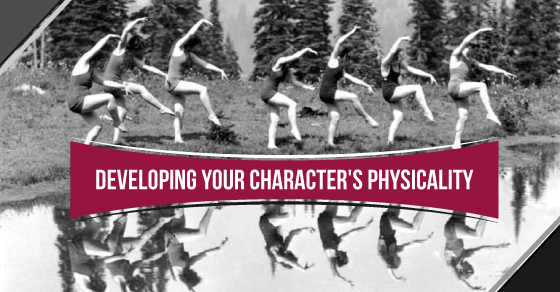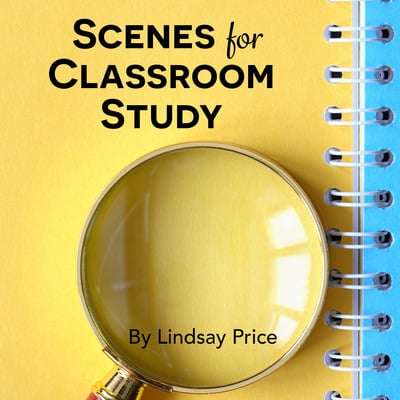Physicalize Your Scene Work
Whether adjudicating for a full length or a monologue competition, one of the most frequent comments I make is that students need to work more at developing the physical side of their characters. We often spend a lot of time developing the nonphysical part of a character: character profiles, reflection, getting into the text. Sometimes student actors leave a character’s physicality to the last minute or they do not incorporate it at all. This results in some students ending up with characters that look, stand, sit, and move a lot like they do on a daily basis.
Body language accounts for 60% of our understanding of emotions, our reception of subliminal messages and our grasp of relationships.
-Ron Cameron-Lewis, Acting Skills for Life
How do I encourage students to physicalize their characters?
- Take the scene you’re working on and have the actors play the scene without dialogue. They have to communicate their lines nonverbally. What do they do to replace what they say? Remind students to stay in character as they try to communicate. Is this character patient or impatient as they physicalize their lines? Do they make small or large gestures?
- Before every blocking move, have the actor say “I am moving because I am….” They can only move if they can come up with a character-driven reason to move. This will eliminate the problem of actors who move only because a director told them to do so.
- Do a scene with just the blocking and no dialogue. Have actors say their lines in their heads and do any blocking they’ve been given. Discuss the experience afterward. What does it feel like to focus on the movement? Did you ever feel like you were in one place for a really long time? Do you feel your blocking is character-driven?
- Create a character zero for each character. Character zero is used in Commedia dell’arte. It is the defining pose that a character presents every time they enter or stand still in the space. If you’re doing a realistic piece, it won’t be practical to have a character pose every time they enter a room. But it is something you can play with during rehearsal. You can also pick and choose your character zero moments. Character zero also helps your actors identify what makes their character physically unique from them. That is what is most important.
- To encourage levels in a scene, do the “sit, stand, kneel” improv game. If you have only two actors, then do “sit, stand.” If you have more, you can do “sit, stand, kneel, lie down, stand on a chair.” As actors perform the scene, have only one person be in one physical state at a time. For example, two actors can’t stand at the same time. If someone is sitting, then have everyone else be in one of the other states. Actors are allowed to stay in one state for only 5 seconds.
- Have actors come up with an action for each line in a scene. It could be moving from sitting to standing. It could be moving a pillow from a chair to the couch, or clearing the table. The aim is to experiment with possible actions for a scene. Certainly you don’t want your actors moving constantly during a performance, but too often actors sit down and never move. They become motionless, talking heads. This exercise will help actors identify what they are doing in a scene. What if the character is trying to share a secret while cleaning a table at the same time? Or folding laundry? How does the action compliment or contrast with the text?
- Videotape a scene. When you watch the scene back, focus on the actor-driven movement. When do the actors shuffle from foot to foot? When do they brush their hair from their face or adjust their clothes? When do they raise a hand and plop it down on their thigh? These are all nervous gestures that actors do, not characters. It takes the audience out of the world of the play. Identify these moments and work to remove them from the action of the scene.
- Have actors play the scene with a specific body lead. What if a character lead through the nose? Or through the belly? Or through the knees? How does the character change with this physicality? It might work or might not, but it’s important to try. It’s another fun thing to play with during rehearsals.
- Have actors play the scene with a specific foot plant. First do the scene with everyone walking normally- a “heel, toe” foot placement. Next, do the scene with everyone walking with a “toe, heel” foot placement. Be specific and careful, focusing on each step being “toe, heel.” The third time, do the scene with everyone walking on the inside edges of their feet. The fourth time, have everyone walk on the outside edges of their feet. All of these foot placements will change the personality as well as the physicality of the character. If actors get frustrated, tell them to let their frustration out through their characters!
Related Articles
Scenes for Classroom Study
by Lindsay Price
Scenes for Classroom Study consists of scenes from published Theatrefolk plays and is designed to help with character study, scene work, substitute teachers, performance, Individual Event competitions and so much more.
Ensemble Scene Collection
by Lindsay Price
Looking for quality scenes for your ensemble that haven't been done a million times? This Ensemble Scene Collection contains 33 scenes from published plays - great for competition and classwork!





